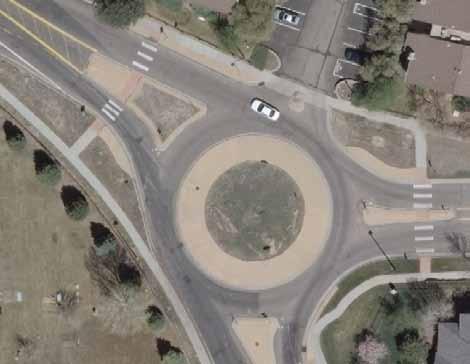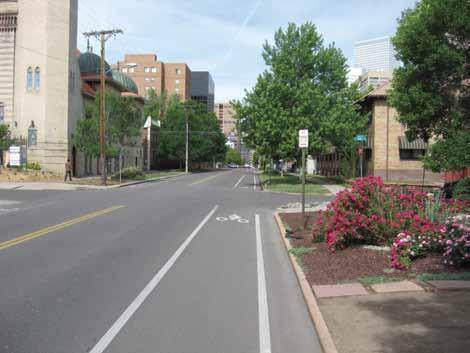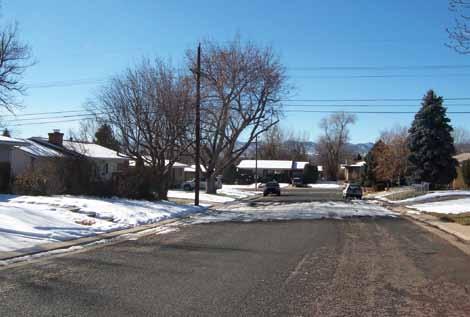
4 minute read
Winter maintenance considerations in transportation planning
Pat Kennedy, P.E.
Engineering Supervisor, Denver Street Maintenance Denver, Colorado Member, APWA Winter Maintenance Subcommittee
Advertisement
hether constructing new or expanding existing roads, the planning for a major project brings together many disciplines, each having a different frame of reference and focus. Transportation is more than just cars; there is mass transit, light rail, bicycles, and pedestrians moving around in the same corridors. Pavement design, lane configurations, streetscape elements, vegetation, storm drainage, and public art are all part of the planning process. Rarely, however, does winter maintenance become part of the planning effort, but minor design details can have major consequences when winter arrives.
Roundabouts assist in slowing traffic while increasing safety and mobility of the public. These items can also be a hazard when snow has decreased visibility or partially covered them. Plow drivers are maneuvering heavy pieces of equipment during marginal weather when visibility is low. A plow impacting a curb can damage both the equipment and the curb line. Sloped curbs instead of vertical curbs along the central or channelling medians can create the visual barrier needed for traffic but a plow blade will ride up over the curb minimizing the damage and injury potential. The turning radius of plow equipment must be considered when setting the curves and locations of curbs associated with these structures so they may be properly cleared of snow. Roundabouts also create unique problems with snow storage. The entrances and exits, as well as pedestrian facilities, use up much of the available perimeter space that could be used for snow storage. Placing snow in the central island will create icing problems if the pavement slopes away from the center. Melt will flow across the pavement and refreeze at night creating hazardous conditions.
Traffic calming devices such as intersection bulb outs and center refuge islands provide a safer pedestrian environment, but they are also obstructions to plowing operations requiring skilled maneuvering by the plow driver. Bulb outs also create pockets that are difficult to clear and can become collection points for debris and snowmelt if not properly constructed with drainage structures.
Many cities are undergoing a change in the way that lanes are laid out. Parking is being removed and bike lanes are taking their place. What may have previously been used as storage for plowed snow now must be cleared for the bicyclists that are using the streets for commuting. Additional passes by the plow will be necessary and, in some extreme cases, expensive and time-consuming snow hauling will be needed.
Pavement in a shaded area will be 10°F or more cooler than pavement exposed to the sun. Snow that falls

Bike lanes can eliminate snow storage area.
in this area will melt slower, or not at all, compared to snow in a sunny area. Melt water can enter these cooler areas and refreeze, creating ice accumulation. The placement of buildings, fences and even deciduous trees will have an effect on icing patterns on streets.
Sidewalks are an integral part of an urban transportation network. If the available right-of-way allows a detached sidewalk, or walk that is separated from the curb line, it is less likely to be buried with snow by a plow. Citizens are not happy when they just spent time and energy clearing their walk only to see it all ruined in 30 seconds. Full width plowing is critical to open drainage paths for snow melt to enter storm sewers. Setting sidewalks back as little as five feet from the curb line provides a snow storage zone that allows curb-to-curb street clearing in minor storms and still provides pedestrian mobility.
Storm sewer systems are designed to carry storm runoff sway from streets. While storm sewers themselves have little effect on the development of ice on streets, the placement of an inlet can have a positive impact on the extent of ice formation. An inlet in or near a shady area will soon be wrapped in ice. That same inlet, if placed in a location to allow sun exposure, can allow for collection of some of the snow melt and lessen the formation of ice along the edges of streets. Vegetation is an important part of the urban environment. Some plants are better suited to occasional exposure to deicing chemicals. The effects are not limited to salts in the soil entering the plant through the root system. A 2008 study out of the University of Colorado showed that overspray from liquid deicers coated the needles of pine trees, closed pores and damaged the tree from the outside. Consult with experts on what are better plants to use along the corridor.
There are other factors in urban roadway construction that can impact snow response. At the APWA National Congress in Anaheim, Calif., in August, a panel discussion will be held with snow experts from the U.S. and Canada. We invite you to come learn from these pros about the little things you can implement with a design and build a project that fits the community needs, is a showcase of attractive design, and is not a burden during winter months.
Pat Kennedy can be reached at (303) 446-3535 or william.kennedy@ denvergov.org.








